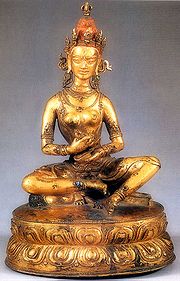- Nairatmya
-
 Nairatmya, Central Tibet, sixteenth century. Gilt copper inset with turquoise, painted with red pigment, H9.25 in. (23.5 cm). Los Angeles County Museum of Art, From the Nasli and Alice Heeramaneck Collection, purchase, M.70.1.4. Nairatmya represented as a seated yogini, her face ablaze with all-seeing wisdom.
Nairatmya, Central Tibet, sixteenth century. Gilt copper inset with turquoise, painted with red pigment, H9.25 in. (23.5 cm). Los Angeles County Museum of Art, From the Nasli and Alice Heeramaneck Collection, purchase, M.70.1.4. Nairatmya represented as a seated yogini, her face ablaze with all-seeing wisdom.
Nairãtmyã (pronounced: nai RAHT MYAH, Tib. bdag med ma, pron. Dagmema[1]), translated as "Lady of Emptiness" or "She Who Has Realized Selflessness." is a female Buddha. Buddhism teaches that to perceive ourselves as independent, separate selves, is an illusion. For in truth we are connected with all that exists in a vast web of communion (without self[2]). Nairatmya embodies this realization (also called pudgala- nairatmya, the not-permanent-selfness of persons[3]). Her body is blue, the color of infinite space, reflecting the limitless expanse of her awareness. Like the element of space, she flows through the universe without impediment, for she has transcended ego-centered existence. Her eyes blaze with the wisdom of one who understands the mysteries and depths of life. She raises her curved knife (kartika) skyward, poised to sever negative mindstates wherever they arise. In her skullcup (kapala), she pulverizes illusions and returns them to their original state - a mere play of light, a rainbow of energy, shimmering in empty space.
Contents
Hevajra tantra
- She is enlightened spontaneity in female form,
- A supremely blissful divine yogini.
- She is the mansion of enlightened awareness,
- Possessor of the five Buddha-wisdoms ....
- She is pure, universal awareness,
- The sovereign of the mandala.
- She is Nairatmya Yogini,
- The essence of ultimate reality.
- --- from Hevajra tantra[4][5][6]
Notes
- ^ Dakini's Warm Breath: The Feminine Principle in Tibetan Buddhism by Judith Simmer-Brown (2002) p.110
- ^ The Deeper Dimension of Yoga: Theory and Practice by Georg Feuerstein (2003) p.369
- ^ Early Buddhism - A New Approach: The I of the Beholder (Curzon Critical Studies in Buddhism) by Sue Hamilton (2000) p.121
- ^ The Concealed Essence of the Hevajra Tantra: With the Commentary Yogaratnamala by G. W. Farrow and I. Menon (2003)
- ^ Hevajra Tantra: A Critical Study. 2 Volumes. by D.L. Snellgrove (1959)
- ^ The Hevajra Tantra: A Critical Study Part I: Introduction and Translation Part II: Sanskrit and Tibetan Text (London Oriental Series, Vol 6) by D. L. Snellgrove (1959)
References
This entry is a slightly edited version of the introduction to Nairatmya in Miranda Eberle Shaw's Buddhist Goddesses of India. Princeton University Press. 2006. pp. 387. ISBN 9780691127583. http://books.google.com/books?id=MvDKOK1h3zMC&pg=RA1-PA387&dq=Nairatmya&output=html.
See also
- Sitatapatra
- Narodakini
- Saraswati
- Queen Maya
- Hariti
- Yakshini
- Prithvi
- Simhamukha
- Vajrayogini
- Tara (Buddhism)
Buddhism Buddhism portal Categories:- Buddhas
- Yidams
- Female buddhas and supernatural beings
Wikimedia Foundation. 2010.
